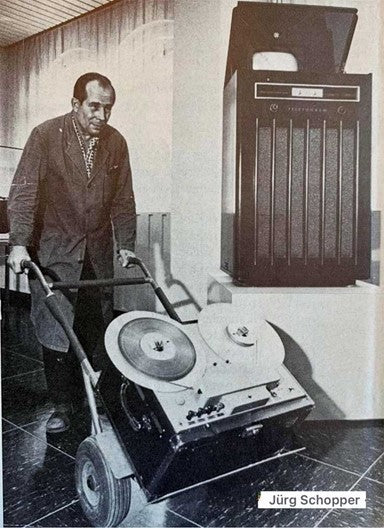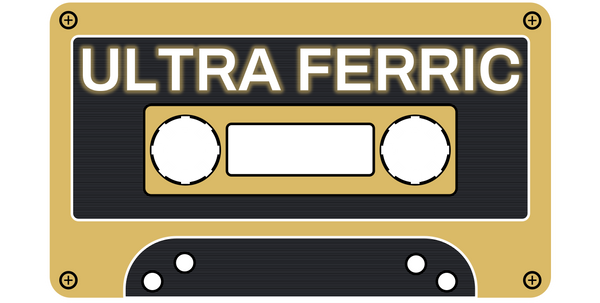
History of Cassette Tapes Part 1: The Dawn of Magnetic Media
Share
Introduction
Long before the digital age brought us the convenience of streaming music and podcasts directly from our smartphones, recording sound has captivated human ingenuity for centuries, but it wasn't until the late 19th century that technology caught up with ambition. From wax cylinders to vinyl records, each innovation brought with it new possibilities and limitations. In this first article of the series, we'll revisit the origins of recordable magnetic media, highlighting the groundbreaking transition from mechanical to magnetic recording techniques.
Early Recording Media: From Wax to Vinyl
The story of recording media began in the late 19th century with the invention of the Phonograph by Thomas Edison in 1877. This rudimentary, yet revolutionary device used a sheet of tinfoil wrapped around a cylindrical drum. As the cylinder rotated, a stylus moved across the tinfoil, indenting it with vibrations picked up by a mouthpiece. This mechanical process allowed sounds to be recorded and then played back by re-tracing the stylus over the same indentations, causing another diaphragm to vibrate and reproduce the sound. Despite its revolutionary impact, the tinfoil phonograph had several limitations. The tinfoil was fragile and could only be played back a few times before it wore out.

1: Thomas Edison with his second phonograph, photographed by Levin Corbin Handy in Washington, April 1878
The quest for better quality and durability led to Alexander Graham Bell's Volta Laboratory Graphophone, which replaced tinfoil with wax—a significantly more durable material that allowed for clearer sound playback. Bell's phonograph cylinders became a commercial success in the late 1880s, but they still faced limitations in terms of fidelity and long-term usability.

2: A 'G' (Graham Bell) model Graphophone being played back by a typist after its cylinder had recorded dictation.
The next major development in recording media came with Emile Berliner's Gramophone, which utilized flat-disc records initially made of glass and later zinc and eventually shellac. Introduced in the 1890s, these discs were easier to produce and store than cylindrical records. However, like their predecessors, gramophone records were prone to wear from the mechanical playback process, which gradually degraded the sound quality.

3: Emile Berliner (1851-1929) with the model of the first phonograph machine which he invented.
The Magnetic Tape Revolution
As the limitations of mechanical recordings became evident, the scene was set for a major breakthrough. This breakthrough came with the development of magnetic tape recording. Initially investigated in the early 20th century, magnetic recording diverged significantly from its predecessors by using a magnetizable medium to record sound. The concept of using magnetizable material to record sound was not entirely new, having been toyed with since the early 1900s. However, it wasn't until the 1930s, particularly in Germany, that the technology was refined and became practical.
The first practical magnetic recorder was developed in the early 1930s by German engineer Fritz Pfleumer. Pfleumer patented a method of recording using a magnetizable strip of paper coated with iron oxide powder. This invention caught the attention of AEG, a German electronics company, which collaborated with the chemical giant IG Farben to develop the first commercial tape recorder, the Magnetophon, along with BASF (part of IG Farben) developing the tape.

4: The first Magnetophon; AEG model K1
The Magnetophon used a plastic-based tape coated with iron oxide, marking a substantial improvement in sound fidelity and durability over earlier recording technologies. It recorded audio by converting sound waves into electrical signals through a microphone, then using these signals to alter the magnetic orientation of the iron oxide particles on the tape. The ability to capture a wide range of frequencies and the ease of editing and duplicating recordings made magnetic tape a revolutionary medium in the fields of audio recording, broadcasting, and later, computing.
How Magnetic Tape Works
The brilliance of magnetic tape lies in its method of encoding audio information. As the recording head receives an electrical audio signal, it generates a magnetic flux that varies with the signal. This flux changes the magnetic orientation of the ferrous particles on the tape.

5: Sound recording on magnetic tape
For playback, the process is reversed. As the magnetized tape passes by a playback head, it induces an electrical signal in the head, replicating the original sound waves. This process, free from the physical contact required by phonographs and gramophones, greatly reduces wear and increases the longevity of the recording medium.
* In the following chapters we will explore the technical aspects of magnetic media, and specifically cassette tapes in much more depth.
Challenges and Advantages
Despite its advantages, early magnetic tape technology faced significant hurdles. Early magnetic tapes were plagued by issues, such as print-through (where magnetic signals from one layer of tape could transfer to another), high levels of background noise, limited frequency and dynamic range, and sensitivity to environmental conditions like temperature and humidity.
Engineers tackled these problems by continuously improving the materials used in tapes and refining the design of recording and playback heads. The introduction of acetyl cellulose tape base, and later polyester, provided greater strength and stability. Developments in materials science led to the introduction of new types of magnetic particles, such as chromium dioxide and cobalt-evaporated tapes, which offered higher coercivity and better frequency response. These innovations, coupled with improvements in the design of recording heads and the introduction of noise reduction technologies like Dolby B and C, significantly enhanced the performance of magnetic tape.
Despite these challenges, the advantages of magnetic tape were clear. It offered far superior sound quality and durability compared to wax cylinders and vinyl records. Additionally, magnetic tapes could be recorded over multiple times without significant loss of quality, a significant advantage for both amateur and professional users.
Moreover, the ability to record hours of audio on a single, compact reel of tape or eventually in cassette form was revolutionary. This capability made magnetic tape ideal for a wide range of uses, from home recording to radio broadcasting and professional music production revolutionized the recording industry.
Conclusion
The invention of magnetic tape marked a significant milestone in the history of recordable media. It set the stage for future innovations in both audio and video recording, paving the way for everything from cassette tapes to VHS tapes, and eventually to digital recording methods. As we explore further into the evolution of recording technologies in the following articles, we'll see how magnetic tape continued to evolve and influence the media landscape.
The journey from Edison's phonograph to the compact cassette is a fascinating story of innovation, adaptation, and the endless human quest to capture and recreate the ephemeral nature of sound.
As we move into the next parts of this series, we will explore the rise of cassette tapes, their inner working and intricacies, their cultural significance during the 1970s and 1980s, and their enduring legacy in the age of digital media.
Photo and Figure Credits
- https://en.wikipedia.org/wiki/Phonograph#/media/File:Edison_and_phonograph_edit1.jpg
- https://en.wikipedia.org/wiki/Phonograph#/media/File:Transcription_using_cylinder_phonograph.png
- https://en.wikipedia.org/wiki/Phonograph#/media/File:Emile_Berliner_with_phonograph_(cropped_portrait).jpg
- https://museumofmagneticsoundrecording.org/images/R2R/AEGK1TapeRecorder.jpg
- https://edisontechcenter.org/MagRec.html

2 comments
Very interesting. I’m cvurious where/when Wire recording fits into this evolution?
VERY well done!!!! Thank you!!!